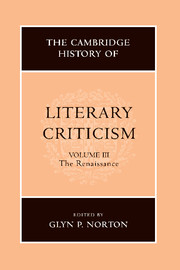Book contents
- Frontmatter
- Introduction
- READING AND INTERPRETATION: AN EMERGING DISCOURSE OF POETICS
- POETICS
- I Humanist classifications
- II The rediscovery and transmission of materials
- III Rhetorical poetics
- IV Literary forms
- 20 Italian epic theory
- 21 The lyric
- 22 Renaissance theatre and the theory of tragedy
- 23 Elizabethan theatrical genres and literary theory
- 24 Defining comedy in the seventeenth century: moral sense and theatrical sensibility
- 25 Dialogue and discussion in the Renaissance
- 26 The essay as criticism
- 27 The genres of epigram and emblem
- 28 Humour and satire in the Renaissance
- THEORIES OF PROSE FICTION
- CONTEXTS OF CRITICISM: METROPOLITAN CULTURE AND SOCIO-LITERARY ENVIRONMENTS
- VOICES OF DISSENT
- STRUCTURES OF THOUGHT
- NEOCLASSICAL ISSUES: BEAUTY, JUDGEMENT, PERSUASION, POLEMICS
- A SURVEY OF NATIONAL DEVELOPMENTS
- Bibliography
- Index
- References
27 - The genres of epigram and emblem
from IV - Literary forms
Published online by Cambridge University Press: 28 March 2008
- Frontmatter
- Introduction
- READING AND INTERPRETATION: AN EMERGING DISCOURSE OF POETICS
- POETICS
- I Humanist classifications
- II The rediscovery and transmission of materials
- III Rhetorical poetics
- IV Literary forms
- 20 Italian epic theory
- 21 The lyric
- 22 Renaissance theatre and the theory of tragedy
- 23 Elizabethan theatrical genres and literary theory
- 24 Defining comedy in the seventeenth century: moral sense and theatrical sensibility
- 25 Dialogue and discussion in the Renaissance
- 26 The essay as criticism
- 27 The genres of epigram and emblem
- 28 Humour and satire in the Renaissance
- THEORIES OF PROSE FICTION
- CONTEXTS OF CRITICISM: METROPOLITAN CULTURE AND SOCIO-LITERARY ENVIRONMENTS
- VOICES OF DISSENT
- STRUCTURES OF THOUGHT
- NEOCLASSICAL ISSUES: BEAUTY, JUDGEMENT, PERSUASION, POLEMICS
- A SURVEY OF NATIONAL DEVELOPMENTS
- Bibliography
- Index
- References
Summary
While the word ‘epigram’ entered the French language at the end of the fourteenth century, it remained rare until the sixteenth, and the earliest citations of the word in the Oxford English Dictionary all date from the sixteenth century. Likewise, the term did not become common in German until the sixteenth and seventeenth centuries. The modern epigram does seem in some respects to be truly an invention of the Renaissance. And like the other truly Renaissance genres, the emblem and the essay, it is a genre whose development was directed to some extent by its etymology as it was assembled from a combination of classical models and medieval subliterary gnomic traditions. The word meant ‘inscription’ in the classical languages, and Renaissance epigrams too were often meant to serve as literal or figurative inscriptions for real or putative monuments or works of art.
Naturally, the epigram was not an entirely new form. In Germany the Baroque epigram was in some respects closer to the medieval Spruch than to the classical epigram. In French poetry, short-form verse, ending with a proverb or a famous line of poetry, was common in the later Middle Ages following the example of Eustache Deschamps, and these short forms were even discussed in some detail in the arts of seconde rhétorique. Since late antiquity, gnomic sayings had been stretched into distichs or other combinations of rhyming verse for mnemotechnic considerations, in ways that often turned them into epigrams in all but name. Like the ancient epigrams, these short poems provided tituli, or captions and inscriptions, for mosaics, tapestries, and stained glass windows.
- Type
- Chapter
- Information
- The Cambridge History of Literary Criticism , pp. 278 - 283Publisher: Cambridge University PressPrint publication year: 1999
References
- 1
- Cited by



